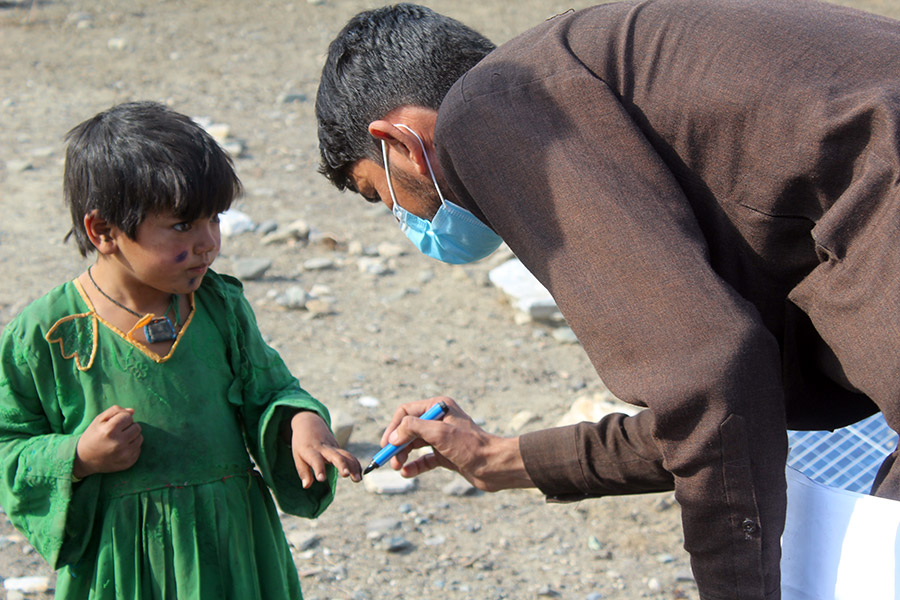 A vaccinator marks the finger of a young girl in eastern Afghanistan. Photo credit: WHO EMRO
A vaccinator marks the finger of a young girl in eastern Afghanistan. Photo credit: WHO EMRO
The polio programme has operated in Afghanistan for more than two decades, through insecurity and conflict, adapting its strategies and operations to local level realities. Together with Pakistan, the two neighbouring countries form one epidemiological block and are the only two countries where wild poliovirus remains endemic.
2021 was the year of lowest polio transmission in Afghanistan, providing the best opportunity to interrupt transmission and achieve eradication. Four children suffered paralysis from wild poliovirus (WPV1) in 2021 compared to 56 children in 2020: one in Ghazni province in the southeast and three in Kunduz province in the country’s north. In January 2022, a two year old girl was paralysed after contracting the virus in Paktika province in the south east. All three provinces were largely inaccessible to vaccinators prior to the resumption of nationwide campaigns in late 2021.
Forty-three children were paralysed by cVDPV2 in 2021, the last child affected in July, compared with 308 in 2020.
WPV1 and cVDPV2 is still being detected from environmental surveillance sites across the country.
Responding to dual transmission of WPV 1 and cVDPV2
Access issues and resulting immunity gaps leaving children vulnerable to poliovirus are just one outcome of the insecurity and broader humanitarian crisis faced by Afghanistan.
In April 2019, the Taliban authorities banned all polio vaccination activities in areas under their control. The ban was partially lifted in late September 2019 to allow vaccinations to take place at local health facilities. While house-to-house vaccinations continued in other parts of the country, restricted access greatly impeded the programme’s ability to conduct high-quality campaigns and left an estimated three million children (30% of the targeted total) inaccessible across the country. This situation was further exacerbated by the COVID-19 pandemic. All polio immunization campaigns were paused from March to July 2020, and resources repositioned to support the COVID-19 response.
Polio campaigns resumed in July 2020, and the programme has since made rapid progress in containing poliovirus importation to polio-free areas across Afghanistan. The south and east regions, which have historically been polio reservoirs, have seen a steady decline with no cases of WPV1 in the east since March 2020 and none in the south since October 2020. No WPV1 cases have been reported from the west of the country since September 2020.
In 2021 five NIDs were conducted (in January, March, June, November and December) using tOPV and bOPV, targeting 9.9 million children under five years in each round. The programme welcomed the support and cooperation of the Taliban authorities that allowed the resumption of nationwide vaccination campaigns in November 2021. Three further campaigns have since been conducted.
Despite this progress, immunization gaps due to inaccessibility and vaccine hesitancy persist in the south and southeast. Afghanistan’s polio programme is ramping up work to improve campaign quality, integrate the delivery of polio services with other essential health programmes, and address refusals in order to reach all children and end polio once and for all.
Polio surveillance in Afghanistan
Despite insecurity and accessibility challenges, all key acute flaccid paralysis (AFP) surveillance indicators in Afghanistan are above global standards. The country has a broad community-based AFP surveillance network and continues to detect cases of AFP and confirm cases of polio caused by WPV1 and cVDPV2. The AFP surveillance system is complemented by an extensive environmental surveillance network of 29 fixed sites and three ad hoc sites across Afghanistan which enhances the programme’s ability to detect WPV1 and cVDPV2.
In late 2021, the polio programme completed a desk review of the Afghanistan programme’s surveillance system in order to identify any localized gaps and further strengthen the system. The review was supplemented by virtual interviews with the surveillance workforce in Afghanistan and found that the country’s poliovirus surveillance system continues to meet and exceed global surveillance standards at national and most sub-national levels. The desk review also confirmed that the reduction in poliovirus detection in Afghanistan in 2021 to be an accurate reflection of true epidemiologic picture despite the broadening immunization gaps as demonstrated in reported dose histories of non-polio AFP cases.


